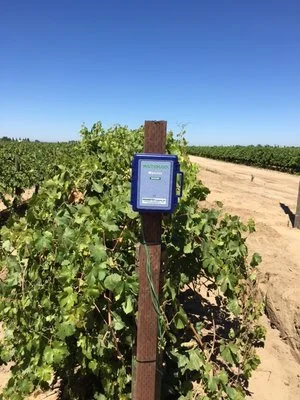In a partnership with the Strategic Growth Council and the California Department of Food and Agriculture (CDFA), the University of California Agriculture and Natural Resources (UC ANR) is providing outreach, education, and technical assistance to farmers and ranchers across California
Technical Assistance Supports Wildfire Recovery Efforts in Sonoma County
Investments in Social Resilience Support Adaptation to COVID-19 Challenges
The COVID‑19 pandemic has exacerbated existing food insecurity in the Watts community in Los Angeles, where the Transformative Climate Communities Program in 2017 made a $33.25 million investment of California Climate Investment funds to implement the Watts Rising vision. To ensure continued access to fresh produce throughout the pandemic, the Watts Rising collaborative partners harnessed their existing virtual community engagement events as a platform to distribute food and critical public health information.
Transform Fresno Initiative Brings Solar and Energy Efficiency Projects to Low-income Households
Transformative Climate Communities Supports a Vision for a Healthier Watts
Community Members Lead Transformative Climate Solutions in Southwest Fresno
Climate-Smart Irrigation in Coachella Valley
With support from CDFA’s State Water Efficiency and Enhancement Program (SWEEP), the Desert Fresh project lowered irrigation water use by nearly 15 percent while producing the same yield using precision agriculture technology. The system also uses soil moisture sensing technology to identify when the crop needs water and know exactly how much to apply—taking the guesswork out of irrigation.
Enhanced Irrigation Tools and Solar PV System Bring Efficiency to Fresno Farm
Engaging Diverse Audiences Through the Student Ambassador Program
Volunteering as a Student Outreach Ambassador
Demonstrating Regenerative Agriculture through Education, Training, and Research
In the fifth round of its Sustainable Agricultural Lands Conservation program, the California Strategic Growth Council approved a $1,550,000 grant from California Climate Investments to the Land Trust of Santa Barbara County to purchase an easement that will permanently protect the 999‑acre Jalama Cañon Ranch. This year, with support from the California Department of Conservation and in partnership with the White Buffalo Land Trust, the Land Trust of Santa Barbara County focused on laying the groundwork for the agricultural easement so it can protect these agricultural and natural lands from conversion to more greenhouse gas‑intensive uses.
Sustaining Productive Agriculture at Brazelton Ranch in Vacaville for Generations to Come
The Brazelton family, in partnership with the Solano Land Trust, will ensure the Brazelton ranch in Vacaville remains intact in perpetuity by placing their property under a conservation easement. Conservation of farmlands that surround urban areas helps promote infill development, avoid GHG emissions, and maintain a viable agricultural economy in the region.
East Lake Berryessa Conservation Easements Protect Wildlife, Watersheds, and Woodlands
Protecting Prime Farmland on the Urban Edge in Contra Costa County
The Cecchinis worked with a local land trust that was willing to purchase an easement on their property, and the land trust secured Cap-and-Trade dollars through the Sustainable Agricultural Lands Conservation (SALC) Program to purchase the conservation easement and permanently protect the land. The easement holder, Central Valley Farmland Trust, extinguished development rights on the property while the landowners retained ownership of the land.
Connecting a Coachella Valley Elementary School with Safe and Resilient Water Supplies
Westside Elementary School in the Coachella Valley relied solely on well water for its drinking water. The well had an unfortunate history of both contamination and the inability to provide adequate water supplies to prevent fires. Thanks in part to a nearly $370,000 from California Climate Investments through the Safe and Affordable Drinking Water Fund, these problems have been solved.
Ukiah Students Breathe Easier Thanks to New Zero-Emission Buses
North Coast Resource Partnership Plans for Forest, Watershed, and Community Health
The North Coast Resource Partnership is a unique coalition of North Coast Tribes and seven counties that represent the North Coast and Klamath/Interior Coast Ranges ecological regions, both of which are important carbon storage areas in California. To help protect the health of forests in this territory, the North Coast Resource Partnership is using $4,037,500 of California Climate Investments funding through the Regional Forest and Fire Capacity Program to develop a regional priority plan that will generate implementation‑ready projects and provide funding for demonstration projects.
Watershed Research and Training Center Coordinates Forest Management Across the State
Powering Organic Agriculture with Solar+Storage
Oya Organic Farms, an organic vegetable farm in Hollister, received a $76,446 grant from California Climate Investments through the Renewable Energy for Agriculture Program that, together with a 76 percent match from the farm, will finance the installation of solar panels to power an irrigation pump and storage/office building. Their new 27‑kilowatt solar system allows the farm to use zero‑emission electricity for their domestic well and re‑invest energy savings towards the farm. Furthermore, a standalone 6.4‑kilowatt solar system coupled with battery storage will power the off‑grid produce storage room and office on the farm.
Prescribed Fire Reporting and Air Monitoring in Shasta County
The Shasta County Air Quality Management District is doing its part to restore resilient, carbon‑storing, and wildfire‑resistant forests and protect public health across northern California with help from a $159,000 grant from California Climate Investments through the California Air Resources Board’s (CARB) Prescribed Fire Reporting and Monitoring Program. The program supports state forest management and wildfire resilience goals by providing local resources that improve the prescribed burn planning, smoke monitoring, and air quality data collection. These improvements facilitate the implementation of prescribed burning, while also providing the Shasta County Air Quality Management District and the public better information on smoke in order to protect human health.






















